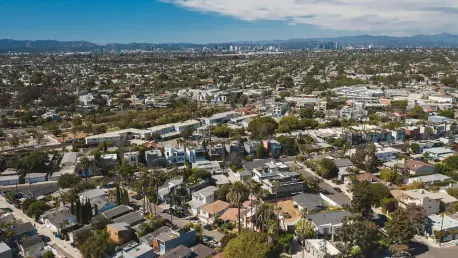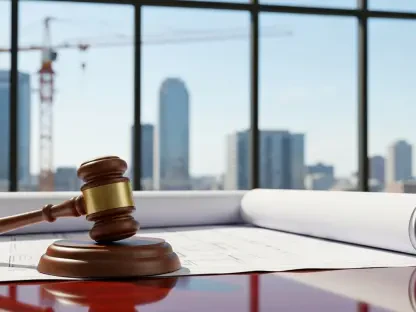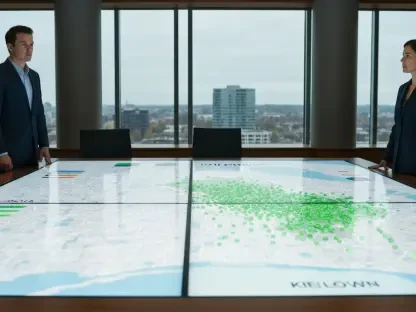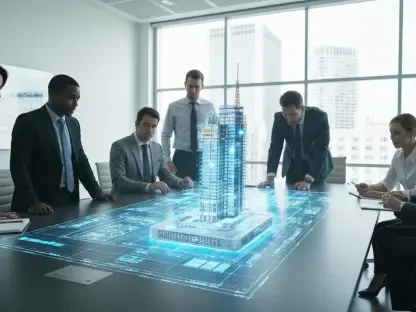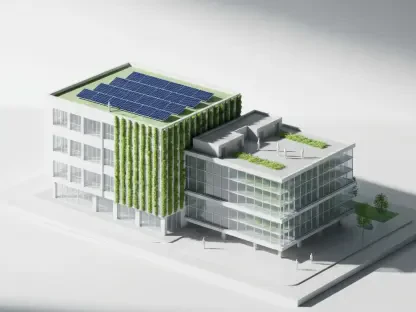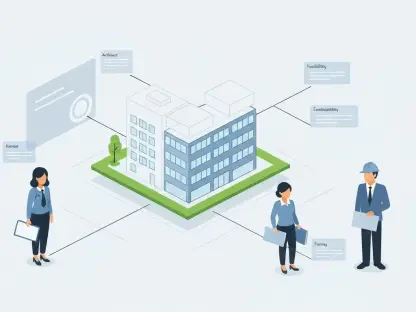Greenwich, an idyllic town known for its tranquility, faces a persistent struggle to balance the demands of urban development with the welfare of its community. As construction activities increase, particularly in the Chickahominy neighborhood, residents endure the repercussions of disruptions that challenge their daily lives and peace. This narrative follows a water service line damage incident caused by a contractor, which led to a prolonged outage, highlighting broader implications and tensions between community preservation and developmental pursuits. The discourse delves into the multifaceted impact of infrastructure disturbances, traffic inconveniences, extended construction projects, regulatory oversight, and overarching trends of urban development.
Infrastructure Disruptions and Emergency Response
Immediate Consequences of Contractor Error
When a contractor accidentally damaged a water main near Hamilton Avenue, chaos ensued, dragging the entire neighborhood into inconvenience and frustration. This unintended incident led to a significant water outage that affected both residents and businesses, prompting concerns over the reliability and robustness of urban infrastructure amidst relentless construction projects. The importance of immediate intervention became glaringly evident as Aquarion’s emergency response crew labored to correct the issue. However, the damage was a stark reminder of vulnerabilities inherent within the urban infrastructure during such developmental activities.
The resolution of the incident, albeit swift, was met with growing frustration from the community, underscoring the need for more resilient infrastructure capable of withstanding accidental disruptions. The apparent fragility revealed through such incidents has amplified the call among the public for heightened safety standards and proactive measures in construction practices. Residents raised alarms over potential recurrent faults, advocating for a systematic upgrade and overhaul of essential service lines to prevent future occurrences.
Broader Implications for Urban Development
The water outage spotlighted the broader issue of systemic preparedness within the urban landscape and the perceived inadequacy in addressing emergent crises. Many residents questioned the current strategic approaches to urban planning, demanding comprehensive reviews and reforms. The recurring debates on infrastructure development have brought forth critical reflections on how best to balance growth with secure living environments. The incident induced an introspective look into the gaps between development ambitions and infrastructure readiness, alongside exploring innovative solutions and sustainable practices that minimize disruptions.
The narrative resonates with similar instances across growing cities, where development pressures inadvertently uncover inadequacies within existing frameworks. This incident in Greenwich serves as a microcosm for larger urban development discussions, wherein gentrification and modernization are juxtaposed against aging infrastructure. It urges policymakers and developers to craft strategies that foreground resilience and rapid response capabilities, ensuring community welfare is upheld within the shifting dynamics of urban evolution.
Traffic Chaos and Community Frustration
Unforeseen Traffic Rerouting Challenges
In the aftermath of the water main error, traffic rerouting became imperative, leading to delays and commuting headaches for many. The abrupt diversion raised significant challenges for local transportation, particularly impacting heavily traveled routes. Altered traffic flows necessitated detours through less accommodating streets, introducing congestion and inconvenience for commuters and pedestrians alike. Businesses suffered adverse effects, with critical service providers struggling under the weight of interrupted logistics and strained operations.
Among the affected establishments was a funeral home that encountered difficulties accommodating guests due to parking shortages and water issues. The compounded challenges during sensitive events further fueled grievances among business owners, who voiced dissatisfaction at the persistent hurdles stemming from prolonged construction activities. Business interruptions like these are reminders of the ripple effects caused by development encroaching on communities, straining relationships, and testing patience within affected regions.
Sentiment Against Prolonged Construction
The construction project aimed at expanding residential offerings on Hamilton Avenue has spanned almost two years, contributing to mounting discontent among residents. Persistent noise, dust, and disrupted property enjoyment have dominated community sentiments, drawing attention to impacts on quality of life. The prevailing sentiment reflects a shared exhaustion over extensive construction periods that encroach on personal space and tranquility. Residents expressed concern that such prolonged activities might harm the collective ethos and aesthetic charm, integral to Greenwich’s identity.
The lingering construction project has kindled broader debates around planning intentions and oversight completeness, questioning if such endeavors align with community needs. Many call for a reevaluation of project timelines and resource allocations, emphasizing a need to prioritize community cohesion and serenity amid ambitious development motions. Voicing these concerns echoes throughout neighborhoods grappling with similar urban development challenges, illustrating a common narrative focused on preserving region-specific value alongside growth initiatives.
Reevaluating Governance Oversight and Regulations
Governance Challenges and Resident Advocacy
The incident highlighted perceived lapses in governance oversight, sparking fervent advocacy among residents for improved regulation. The community outcry centers on reforming construction noise levels and permitting durations that seem to favor development interests over everyday peace. These concerns have catalyzed discussions around policy applicability and enforcement, urging local governance to tighten regulatory frameworks and ensure community voices influence developmental processes.
The escalating dialogue between residents and municipal authorities spotlights critical gaps that exacerbate tensions, urging policymakers to reassess and realign governance strategies with current realities. Residents advocate for a practical approach that safeguards community interests through enhanced transparency in decision-making processes and inclusive policy deliberations. Such conversations illustrate the dynamic between governance capabilities and rising citizen demands, hinting at broader trends of participatory governance in urban environments.
Necessity for Regulatory Revisions
One pressing demand resonating throughout the community is the revision of building permits and noise ordinances, essential for minimizing disruptions to local life. A review of existing regulations could pave the way for balanced solutions that align with evolving development needs while preserving community stability. Some suggest enacting provisional measures to limit construction duration, ensuring projects are concluded swiftly without compromising quality or efficacy.
The necessity for regulatory revisions reflects broader demands for strategic foresight that anticipates developmental impacts and prepares for potential disruptions. By advocating for reform, residents seek a redefined trajectory that embraces harmonious coexistence between urban expansion and community preservation. Regulatory overhauls thus represent actionable steps toward bridging the gap between infrastructure advancement and community aspirations, ensuring sustainable and equitable development practices.
Striking Harmony in Urban Growth
Urban Gentrification and Community Preservation
The prolonged construction and its resulting disruptions mirror overarching trends of urban gentrification seen within many expanding municipalities. Such developments inevitably introduce tensions between growth ambitions and community preservation efforts, leading to a gradual transformation of regional identities. Residents in Chickahominy express pressing concerns over sustaining neighborhood charm and quality of life amidst increasing developmental pressures. The duality between modernizing neighborhoods and preserving local ethos presents a complex narrative that demands thoughtful consideration in urban planning.
Urban gentrification trends often foreground the need for innovative solutions that reconcile developmental aspirations with community welfare. Communities champion participatory approaches, wherein stakeholders collaboratively advocate for policies reflecting balanced growth perspectives. These processes encompass active dialogues, ensuring development trajectories resonate with cultural and social cohesion unique to each locality. Greenwich’s experience highlights the imperative for inclusive frameworks that accommodate multi-dimensional growth perspectives while preserving community values.
Call for Collaborative Solutions
A consensus among residents underscores the necessity for municipalities to balance infrastructure development with the maintenance of community welfare. This dual focus requires synergistic efforts that embrace stakeholder collaboration, integrating community voices into decision-making mechanisms. Policing construction guidelines and forming task forces have been proposed as potential solutions to unify development pursuits with neighborhood preservation. Communities advocate for actionable plans and accountability measures ensuring construction undertakings respect and preserve their collective well-being.
The narrative of prolonged construction reflects an urgent call for multifaceted conversations among developers, policymakers, and residents to enact collaborative solutions that transcend conventional planning models. By fostering stakeholder cooperation and proactive dialogue, urban environments can stimulate balanced growth processes respecting diverse needs and aspirations. Such collaboration embodies an evolving urban narrative that seeks to bridge the development-community divide, crafting solutions resonant with potential interests shared across Greenwich and similar locales.
Navigating Future Directions in Development Oversight
Lessons from Current Conflicts
The implications arising from prolonged construction activities offer valuable insights into strategically approaching future developmental trajectories and governance oversight. One pivotal lesson underscored through these events involves the necessity for adaptive and responsive planning frameworks. Such frameworks must consider evolving infrastructure needs while preparing for unforeseen challenges that underscore urban expansion undertakings.
By analyzing current conflicts, municipalities gain insight into refining development models that prioritize community consultations and integrate resilience as a fundamental attribute within planning contexts. Addressing challenges openly fosters transparent relationships between stakeholders and contributes to shaping environments that are resilient, inclusive, and sustainable. Adaptive planning frameworks thus position authorities to navigate future development undertakings with insight, foresight, and accountability, maintaining resolute focus on community welfare.
Crafting Comprehensive Development Strategies
Greenwich, often celebrated for its serene environment, is embroiled in an ongoing conflict between urban growth and community well-being. As construction efforts ramp up, especially in the Chickahominy area, residents find themselves dealing with disruptions that upset their daily routines and peace. This narrative sheds light on an incident where a contractor damaged a water service line, leading to a prolonged period without water, which underscores broader issues and tensions inherent between maintaining community integrity and the drive for development.
The situation reveals the complex challenges posed by infrastructure disturbances, traffic inconveniences, and protracted construction projects. Residents are increasingly affected by the clash between rapid urbanization and the preservation of their communities. The incident not only draws attention to the immediate consequences faced by locals, but also points to the larger narrative of regulatory oversight and urban development trends that shape their environment.
These tensions highlight the delicate balance required to ensure both progress and the safeguarding of community interests. As Greenwich navigates the pressures of modern development, it becomes crucial to find solutions that mitigate disruption while respecting the town’s character and values. The struggle underscores the importance of thoughtful planning and active community engagement in shaping a future that honors both development and local well-being.
